Meeting a Need
Sep 1, 2020

Hamstede Living Chief Projects Officer Suraj Bhatt (SB) explains the intricacies of the student-housing and coliving segments to your author (SSP).
SSP: What has been the overall response to the student housing and coliving segments, and what is the outlook for these niche real estate categories?
SB: In India’s major educational hubs, there is a big supply-and-demand imbalance in student housing. Few operators offer high-quality, international student accommodations to Generation Z customers. At the moment, this space is served by very few Indian companies. Hamstede Living Pvt. Ltd., with its brand, The Move, plans to meet this demand with its first student-living space in Pune. The facility is planned to rival any international one and set a standard for future purpose-built student housing (PBSH) properties.
Once COVID-19 risks settle down and a vaccine becomes available, the sector will see a very strong bounceback.
The coliving market in India has seen more traction in the past few years. Now, many brands operate in this domain. However, with the projection of 7 million migrant millennials needing professionally managed space by 2023, a huge gap must be filled. High-quality coliving options have yet to make their presence felt countrywide. Bangalore has seen the most action, but other major cities, like Pune, Hyderabad, Mumbai and Gurgaon, have yet to see such products.
While COVID-19 has brought in many challenges, it is also an opportunity for branded student housing and coliving facilities to establish themselves as safe cocoons in trying times.
With information-technology (IT) companies now promoting working from home (WFH), conventional providers of paying guest (PG) accommodations will be unable to provide the needed atmosphere for productive WFH. Coliving, with reliable internet, hygienic food on the premises, power backup, safety and security, will become necessities. In opting for coliving, an employee is assured to spend their WFH time productively. Employers are also assured their employees do not compromise on the safety, security and hygiene their office facilities used to provide. Large corporations may offer premium coliving facilities as an employee perk. While COVID-19 has brought many challenges, it is also an opportunity for branded student housing and coliving facilities to establish themselves as safe cocoons in trying times.
SSP: What are the key market drivers and decision influencers for these categories? What impact has COVID-19 had on them?
From day one, Hamstede has designed and planned properties with access controls in mind.
SB: Proximity to one’s place of work is an important factor that influences the choice between student housing or coliving. Rent affordability is always an important factor. Research shows a customer is willing to pay at least 15% more for good coliving space. In cities such as Mumbai, Bangalore and Delhi, that can be up to 30%. In Bangalore and Delhi, average salaries are higher, and the desire for quality living is greater.
Post-COVID-19, with an unclear economic scenario and loss of jobs, the rental potential of these cities has and will come under stress. There will be a call for more conservative rent underwriting. When juxtaposed against operating cost, this leads to stress on yields. However, once COVID-19 risks settle down and a vaccine becomes available, the sector will see a very strong bounceback.
Regarding touchless technology, its time has arrived due to COVID-19. We foresee it becoming part of the new normal.
SSP: Why is it important to have organized options for sustainable community living?
SB: The current student-housing and coliving market is dominated by PG accommodations that offer an occupant little besides an enclosed space. Millennials and members of Generation Z are the target customers for coliving and student housing, respectively. Both customer bases have a higher living standard than the general public. Generation Z is focused on brands that reflect their values and the fact they do not want the hassles of managing a house.
Organized options fill the gap. A professionally managed, organized player will provide in-house laundry, generous internet bandwidth, power backup, hygienic cafeterias and kitchens, fitness areas, breakout spaces and social events. Residents do not deal with the hassle of water and electricity bills and enjoy an unlimited potential for networking.
Technology will play a very important role in such facilities. Most organized players have in-house apps that provide seamless interaction with property managers. This helps fast-track answers to questions and enhances a hassle-free experience. It is important to understand how coliving is different from traditional PG space. Coliving provides curated spaces designed for community living, which has a tremendous impact on the social and mental wellbeing of occupants.
SSP: What is the unique selling proposition of Hamstede’s offerings?
SB: We have been focused on living up to the concept of community living and not compromising on common spaces in exchange for more room (hence more revenue). An important aspect of PBSH and coliving is it is very close to being a part of the service or hospitality industry. The occupant must experience community living to understand how coliving is different from branded, PG accommodations. Besides comfortable rooms, we design spaces to uplift occupants’ well-being and provide them with sufficient curated spaces to live, work, network, relax and move up in life.
SSP: What are the significance and details of the elevators and escalators at Hamstede projects?
SB: To create nice facilities, the size of the property has to be large. Hence, vertical transportation becomes a very important factor for efficient occupant circulation. Almost all our properties will have elevators as the central spine around which people will circulate. Hamstede is very particular about:
- Accessibility
- Fire and life-safety systems
- Elevator speed
- Elevator fire operation protocols
- Elevator integration with public-address and fire-alarm systems
Such considerations are not a challenge in build-to-suit properties. But, in some conversion properties, achieving the right elevator size becomes a challenge and needs careful consideration. We are also exploring options for access control to elevators that can lend itself to floor separation. Some coliving and student housing facilities will require boys’ and girls’ floors to be separate, so access needs to be controlled.
As a COVID-19 mitigation measure, non-contact elevator panels are becoming a necessity. Bluetooth commands and holographic (instead of standard) call buttons are being evaluated. Maintenance of elevators is very important. The apartment maintenance company (AMC) is also a part of operational cost. Thus, it’s prudent to keep AMC and maintenance in mind when selecting elevators.
SSP: What are the challenges and rewards of providing touchless or hands-free access using apps, barcode scanners, rotating doors and other such measures?
SB: We do not see much challenge in providing touchless or hands-free building access. From day one, Hamstede has designed and planned properties with access controls in mind. Rotating doors, however, should be seen through the lens of whether a property is PBSH or coliving. Student housing can have significant student movement in and out of the property at particular times of day. In very large facilities, this may impede egress and ingress and create queues. This problem can be mitigated, if the budget allows, by having more rotating doors and turnstiles. It is very important to choose the right kind and number of access-control and management solutions by understanding the volume of traffic entering and exiting the property at any given time. Regarding touchless technology, its time has arrived due to COVID-19. We foresee it becoming part of the new normal.
SSP: Do you see any changes in the way lobby areas, elevators and escalators are positioned and operated with advanced technology?
SB: If there is a time to adopt touchless technology in elevators and escalators, it is now. We will see almost all elevators and lobby call buttons now having a touchless option and commands being managed by Bluetooth/holographic projection buttons/infrared activation. This also makes this space very interesting. The speed at which this technology is developing in the elevator space is worth emulating.
SSP: Social distancing is a key aspect of curbing virus spread, but it increases wait time for elevators. How can this be managed effectively?
SB: Unfortunately, with the number of elevators being constant, most users will experience increased wait times. Increased use of stairs may slightly balance this load. Operationally, properties will stagger timing to control crowd movement. For coliving and student-housing facilities, cafeteria times will be staggered and planned by floor, keeping elevator use in mind. After a vaccine is found and the world moves away from COVID-19, normalcy may resume, but touchless technology is here to stay.
Reference
[1] “K+K Sells European Portfolio to Highgate Hotels/Goldman Sachs Joint Venture,” Europe Real Estate, October 27, 2015.About Suraj Bhatt

Hamstede Living Chief Projects Officer Suraj Bhatt has deep roots in the hospitality industry in India and beyond. He has performed due diligence on properties and facilitated the acquisition of many hotels in Australia and Europe. Prior to joining Hamstede Living, Bhatt was head of project management at InterGlobe Hotels. He played a key role in developing numerous hotels, including those under the Pullman, ibis and Novotel brands. Bhatt was part of the mergers-and-acquisitions team that acquired the K+K Hotels group, consisting of 10 hotels spanning Europe’s most popular destinations.[1]





Get more of Elevator World. Sign up for our free e-newsletter.








